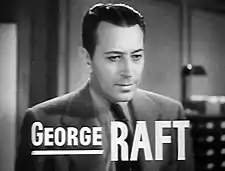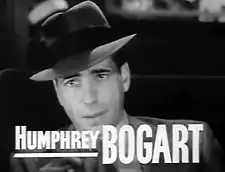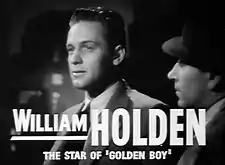Invisible Stripes
Invisible Stripes is a 1939 Warner Bros. crime film starring George Raft as a gangster unable to go straight after returning home from prison. The movie was directed by Lloyd Bacon and also features William Holden, Jane Bryan and Humphrey Bogart. The screenplay by Warren Duff was based on the novel of the same name by Warden Lewis E. Lawes, a fervent crusader for prison reform, as adapted by Jonathan Finn.
| Invisible Stripes | |
|---|---|
 theatrical poster | |
| Directed by | Lloyd Bacon |
| Produced by | Hal B. Wallis Jack L. Warner |
| Written by | Lewis E. Lawes (novel) Jonathan Finn (story) Warren Duff (screenplay) |
| Starring | George Raft Jane Bryan William Holden Humphrey Bogart |
| Music by | Heinz Roemheld |
| Cinematography | Ernest Haller |
| Edited by | James Gibbon |
Production company | |
| Distributed by | Warner Bros. |
Release date |
|
Running time | 81 minutes |
| Country | United States |
| Language | English |
| Budget | $500,000[1] |



Plot
Cliff Taylor (George Raft) is an ex-con who wants to go straight, but since being released from prison on parole, he finds it hard to find and hold a job due to his criminal past. Cliff's younger brother Tim (William Holden) is worried because he cannot afford to marry his girlfriend Peggy (Jane Bryan) and increasingly disillusioned about being able to make a position for himself in the world honestly. Afraid that Tim might end up leading a life of crime like himself, Cliff decides to help him find the money to settle down. He tells his family he has found a job as a salesman, but in reality he gets back to ex fellow convict Charles Martin (Humphrey Bogart) and they organize a number of robberies. With the money he gets from his criminal activities, Cliff is able to buy a garage for his brother, who is now able to get married. Cliff, in the meantime, decides to quit the gang. However, after a failed robbery, Martin and his pals hide in Tim's garage. The police find out, and Tim is taken to the police station. Cliff manages to exonerate his brother from the charges, but in exchange Tim has to identify the robbers and testify against them. Before the police can proceed to arrest Martin, Cliff meets him in his house and tells him to escape before being caught. However, Martin's pals, seeing their boss and Cliff together, understand that they are trying to escape and kill them.
Cast
- George Raft as Cliff Taylor
- Jane Bryan as Peggy
- William Holden as Tim Taylor
- Humphrey Bogart as Charles Martin
- Flora Robson as Mrs. Taylor
- Henry O'Neill as Parole Officer Masters
- Paul Kelly as Ed Kruger
- Lee Patrick as Molly Daniels
- Marc Lawrence as Lefty Sloan
- Joe Downing as Johnny Hudson
- Tully Marshall as Old Peter
- Margot Stevenson as Sue
- Joseph Crehan as Mr. Chasen
- Chester Clute as Mr. Butler
- John Hamilton as Police Capt. Johnson
- Frankie Thomas as Tommy McNeill
- William Haade as Shrank
- Emory Parnell as Policeman
Cast notes:
- Leo Gorcey, who would later become known for playing "Slip Mahoney" in the Bowery Boys series of films, has a small part as the head stockroom boy.
Production
The film was originally set to star James Cagney and John Garfield. Raft then replaced Garfield.[2] Holden ended up replacing Cagney. (The source for this information might have mistakenly reversed the names.) Raft had just signed a long-term contract with Warner Bros.[3]
During a fight scene, William Holden accidentally hit George Raft and caused a gash.[1]
Raft and Bogart made another film together the following year, Raoul Walsh's smash hit They Drive by Night, again starring Raft with Bogart billed fourth (under Raft, Ann Sheridan and Ida Lupino) in a supporting role.
Bogart and Holden worked together again fifteen years later in Sabrina, with Holden billed under Bogart and Audrey Hepburn.
Reception
The film was only a minor success.[1]
Critical reaction
Time Out Film Guide calls Invisible Stripes "A thoroughly predictable tale of the tribulations of an ex-con."[4] A New York Times review from 1940 commented about the unusual lack of prison scenes in the movie. "Let us hasten in all gratitude to add that "Invisible Stripes" is a prison picture in which the stripes are much less visible than usual, most of the action being paroled to the outside in the capable custody of George Raft, Jane Bryan, William Holden and Humphrey Bogart. There are no jute mill scenes, no bullying guards, no big prison break sequence; in fact, we don't understand why they've suddenly commuted our sentence from the customary duration of the picture to a brief prison prelude, a mere graduating exercise at the beginning: good behavior, maybe."[5]
Notes
- Everett Aaker, The Films of George Raft, McFarland & Company, 2013 p. 88.
- "NEWS OF THE SCREEN". New York Times. Mar 6, 1939. ProQuest 102812421.
- Vagg, Stephen (February 9, 2020). "Why Stars Stop Being Stars: George Raft". Filmink.
- Time Out Film Guide review
- Frank S. Nugent (January 13, 1940). "THE SCREEN; David Niven Plays an Unruffled 'Raffles' at the Roxy --Strand Shows 'Invisible Stripes'--New Pix Film". The New York Times.
External links
| Wikimedia Commons has media related to Invisible Stripes (film). |
- Invisible Stripes at IMDb
- Invisible Stripes at the TCM Movie Database
- Invisible Stripes at AllMovie
- Review of film at Variety